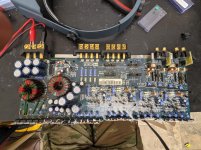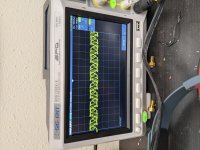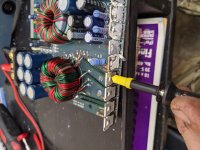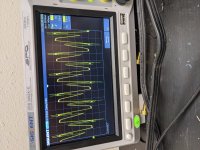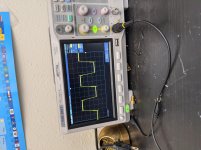Hello All,
I've been trying to ask for help as little as possible, I tend to learn much more when I have to figure something out, but this one is something I don't understand.
When I got the amp, the power FETs were shorted out, so I replaced them.
This amplifier will show a normal signal on the power FETs when the rectifiers are out, but when they were in I get this... where it's like two or 3 waves over top of each other. When the power FETs were out, I had the same signal. I thought maybe it was the driver, so I replaced that, but clearly it didn't help.
I thought maybe someone would have seen it before or have an idea what causes it. I'm all ears!
I've been trying to ask for help as little as possible, I tend to learn much more when I have to figure something out, but this one is something I don't understand.
When I got the amp, the power FETs were shorted out, so I replaced them.
This amplifier will show a normal signal on the power FETs when the rectifiers are out, but when they were in I get this... where it's like two or 3 waves over top of each other. When the power FETs were out, I had the same signal. I thought maybe it was the driver, so I replaced that, but clearly it didn't help.
I thought maybe someone would have seen it before or have an idea what causes it. I'm all ears!
Attachments
I apologize again for the rotated photos, I do not understand why they rotate once I upload them.
The scope isn't triggering properly. Take it off of auto, set the timebase to 10us, the vertical amplifier to 5v/div and the coupling to DC. Adjust the trigger level until it displays one single line of pulses on the base.
Change the vertical amp to 10v and then probe the drains. Readjust the trigger level is needed.
Change the vertical amp to 10v and then probe the drains. Readjust the trigger level is needed.
This is just above 9 volts, iirc.
So is this normal for this amplifier? When I have it at around 13v, it'll show +-25v on the rails. The rectifier wave looks so much different than the other amps I've worked on.
The amp powers up without protection coming on, but unfortunately I haven't set up a test bench in our tiny temporary apartment. I had planned on waiting until I had the amps all ready, then taking them to my shop and testing them all in a vehicle.
So is this normal for this amplifier? When I have it at around 13v, it'll show +-25v on the rails. The rectifier wave looks so much different than the other amps I've worked on.
The amp powers up without protection coming on, but unfortunately I haven't set up a test bench in our tiny temporary apartment. I had planned on waiting until I had the amps all ready, then taking them to my shop and testing them all in a vehicle.
Attachments
The power supply is regulated. When the pulse width decreases (when the rails reach their target voltage), the waveforms won't look perfectly square. Decreasing the 12v supply voltage forces the pulse width to increase to try to maintain the target voltage.
Awesome, thanks for the explanation. Makes sense now!
So when I had the rectifiers out, it wasn't getting any rail voltage and was commanding full pulse width to increase power, which makes for a nice wave.....correct?
Is there any "giveaways" when looking at an amplifier board as to whether or not it is regulated?
So when I had the rectifiers out, it wasn't getting any rail voltage and was commanding full pulse width to increase power, which makes for a nice wave.....correct?
Is there any "giveaways" when looking at an amplifier board as to whether or not it is regulated?
(Side note instead of sending another email) Perry, the amplifier I had asked you about with the single side of rail caps blown ended up having a broken transformer winding. Thanks for the help there as well!
Yes. It was doing all it could to get to the target rail voltage but could not, even with full duty cycle.
Many (not all) of the amps with regulation have inductors in the secondary circuit.
The definition of 'regulated' varies. Some regulation never engages except for over-voltage situations that would cause rail caps to fail. Some regulation is minimal and may be used to make it easier to keep the bias stable at low power. Some regulation is extreme. This is seen in amps that precisely double power when the load is halved (ie, 4 ohms to 2 ohms).
Many (not all) of the amps with regulation have inductors in the secondary circuit.
The definition of 'regulated' varies. Some regulation never engages except for over-voltage situations that would cause rail caps to fail. Some regulation is minimal and may be used to make it easier to keep the bias stable at low power. Some regulation is extreme. This is seen in amps that precisely double power when the load is halved (ie, 4 ohms to 2 ohms).
- Home
- General Interest
- Car Audio
- Xtant 404M
